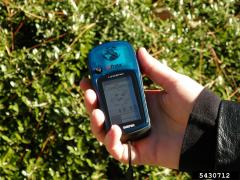You can help with efforts to control invasive species by reporting occurrences of invasive species. The information provided here can help you know what information to report and which method of reporting to choose.
 |
 |
| Use a Smartphone to Gather Data | Or You Can Use a GPS Unit and a Digital Camera |
What Information to Report
Certain basic information requirements are common to most invasive species reporting systems. Gather and provide as much of the following information as you can:
- Location of the invasive species. Provide Global Positioning System (GPS) coordinates if possible. If doing so is not possible, provide an address, or describe the position relative to the nearest crossroads or easily identifiable landmark. Also, identify the town, county, and state.
- Name of the invasive species. Include the common name, and the scientific name if you know it. If the invasive species is a pest, identify the host species (for example, the type of tree on which you saw an invasive insect).
- Date you saw the invasive species.
- Your name and contact information.
- Photographs of the invasive species. Always take pictures if you can do so without risk to yourself or others.
How and Where to Report Information
Because many kinds of invasive species exist, varied reporting methods exist too.
- Report infestations of invasive plants to the Early Detection & Distribution Mapping System (EDDMapS): http://www.eddmaps.org. Follow the step-by-step instructions for entering information into the EDDMapS online form. Examples of invasive plant infestations are tallow trees or wild taro growing along a stream bank or lakeshore, yellow star-thistle growing in a field, or Japanese climbing fern growing in a back yard when the owner did not plant it there.
- Report non-native aquatic species to the U.S. Geological Survey (USGS) Nonindigenous Aquatic Species (NAS) database. You can submit a report electronically at http://nas.er.usgs.gov/SightingReport.aspx, or report by phone by calling 877-STOP-ANS. Examples of non-native aquatic species sightings are seeing non-native fish while boating, catching a non-native fish while fishing, or seeing non-native mollusks or crustaceans while boating or fishing.
- Report a pest or disease of a plant or animal to the USDA’s Animal and Plant Health Inspection Service (APHIS): http://www.aphis.usda.gov/services/report_pest_disease/report_pest_disease.shtml. Examples of pests or diseases of plants or animals are a non-native insect infestation in a field or garden, a disease infecting a herd of animals, or a disease infecting crops. (Also, you can use this source to ask a question related to animal and plant health or regulations.)
- Report a non-native invasive terrestrial animal to your state’s Department of Natural Resources, U.S. Fish and Wildlife Service (USFWS), or other relevant organization. Go to the USFWS Management Offices list: http://www.fws.gov/offices/statelinks.html. Click the name of one of the organizations listed for your state, and then type “report invasive” in the search box. If you can’t find the reporting page, look for a phone number on the site to call for help finding the correct page for reporting a non-native invasive animal.
If you have problems reporting invasive species to a group listed above, or if you have other concerns, contact your county Extension office.
